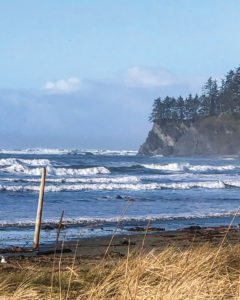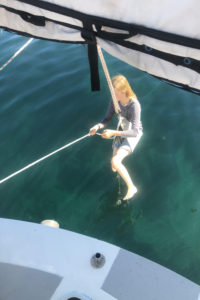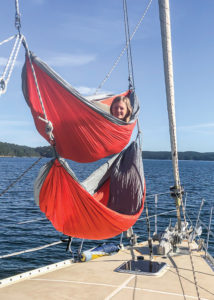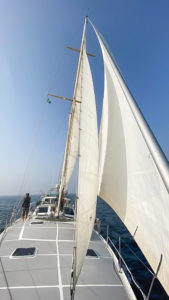This article originally appeared in the June 2021 issue of 48° North.
Never leave two feral ‘tweenager’ kids in charge if you aren’t prepared for some mayhem.
My good friend, Matt Nelson, and I were paddling over to the wave, when bits of music, giggles, and breathless, impatient reminders and questions crackled over the VHF I wore on my chest.
 We had just splashed our surfboards and paddled away from Ocean Watch, my 64-foot charter sailing vessel. My daughter, Dagny, and one of her close friends were on anchor watch, and took the job very seriously, while enjoying themselves immensely. When I glanced over my shoulder as I paddled away, I was not at all surprised to see Dagny’s turquoise-colored aerial silk being hoisted on the staysail halyard. It made me enormously happy to see two kids running back and forth between the foredeck and the VHF to intermittently ask questions about the finer points of hoisting a silk, and also remind me that they, too, wanted to take a turn at surfing.
We had just splashed our surfboards and paddled away from Ocean Watch, my 64-foot charter sailing vessel. My daughter, Dagny, and one of her close friends were on anchor watch, and took the job very seriously, while enjoying themselves immensely. When I glanced over my shoulder as I paddled away, I was not at all surprised to see Dagny’s turquoise-colored aerial silk being hoisted on the staysail halyard. It made me enormously happy to see two kids running back and forth between the foredeck and the VHF to intermittently ask questions about the finer points of hoisting a silk, and also remind me that they, too, wanted to take a turn at surfing.
The day was sunny and warm, and the eastern end of the Strait of Juan De Fuca was glassy and calm. There was a low-and-lazy west swell running. It was late spring, but felt like summer in almost every way but the swell. The Olympic Mountains shone silvery and watchful in the distance, as Matt and I investigated a spot we hoped would generate some good conditions for surfing. We could see small peelers from the foredeck as we anchored, but wave size is sometimes tough to judge at a distance. With the westerly swell and the slack between the ebb and the subsequent flood, the spot appeared to be working. This wave in particular forms over a pointy reef where the depths of the Strait climb from 200 to 300 feet on average, to under 30 feet in the space of about 2 miles.
Typically, the farther east you are in the Strait, the more fickle the surf becomes. This fact is due to its length and the attenuating effects of the currents, as well as the swell-absorbing effects of the bottom contours. Another reductive factor is the gradually decreasing distance between the Olympic Peninsula and Vancouver Island.
The greatest allure of sail-to-surf trips for me has always been access. As long as you can find a place to anchor your vessel — and you can commit to not going ashore — you may explore places that most landlubbers may not reach. Although, one of the most challenging, and therefore rewarding, aspects of sail-to-surf trips is the tension between good seamanship and good surfing. A location where you might find a good wave to surf doesn’t necessarily translate to a safe and comfortable anchorage.
 These facts are how I found myself surfing small waves with Matt that day, as Ocean Watch rolled gently in the swell while two tow headed hooligans kept an eye on things.
These facts are how I found myself surfing small waves with Matt that day, as Ocean Watch rolled gently in the swell while two tow headed hooligans kept an eye on things.
We had found a spot where a VW-beetle-sized granite glacial erratic split the wave into a left AND right point break…we had options. On that day, if you chose the left, you needed to stay high on the wave to keep your fin clear of the reef as you passed over it. A crash here would have proved educational, and would almost certainly have gifted a few new scars…but the rides were long. If you choose the right, deeper water but a shorter ride would be your reward. Each wave we caught was a cost/benefit analysis. We usually went left.
As a result of the riskier conditions that day, I declined to allow Dagny and her friend a crack at getting flayed by the sharp rocks. This news was met by a demand for the promise of another trip (very soon) where we could surf together. Dagny has always loved being in the water, and surfing is the cherry on top. Matt and I returned to Ocean Watch happy and hungry for more trips like this. We made lunch and made our way back across the Strait to Orcas Island.
Four months deeper into the quarantine, and desperate to get away from Orcas, Dagny and I sailed across the Straits again in search of surf. The forecast showed an 8-foot northwest swell in two days’ time. September sessions were upon us.
We left the Strait of Juan De Fuca Lighted Buoy 4 to port as we neared Angeles Point. There are a number of waves near the mouth of the Elwha that need no introduction for surfers in the Pacific Northwest. Anchoring in this area is a bad idea for anything beyond short term. Unless you are a really big vessel. The very swells you come here to surf make life really uncomfortable at anchor.
 Fortunately, the day Dagny and I arrived, neither of us wanted to hang out aboard. We planned to anchor near the Elwha only to surf for a while, then head someplace else for the night.
Fortunately, the day Dagny and I arrived, neither of us wanted to hang out aboard. We planned to anchor near the Elwha only to surf for a while, then head someplace else for the night.
Another of the many things I love about sail-to-surf, is how analogous it is to the earn-your-turns mantra for which backcountry skiers pride themselves. If you have sailed yourself to a spot in hopes of surfing, it is incredibly unlikely you will leave without surfing. It is one experience to sit in your car with a hot drink, pondering whether or not the wave on the other side of your windshield is worth getting cold and wet for…and quite another to approach a wave from the water.
Approaching by water, you will surf whatever is available, while many of the latte-sippers up in the parking lot go back home to read a book or weed the garden when they find less-than-ideal conditions. Or they might drive from spot to spot all day looking for better conditions — perhaps eventually jumping in the water, perhaps not. I’ve been there too. Comfort is a trap that is difficult to free yourself from.
By contrast, I have found that within minutes after anchoring in a spot to surf, we are wiggling into wetsuits and either paddling or skiffing in to go surf. We jump in the water no matter what. We earned this. Instead of the search for perfection, we just get in the water, and see what mother ocean has for us.
 The day we arrived at Angeles Point, we found waist- to chest-high waves that gave no small relief from the dim anxiety of watching Ocean Watch rolling about all alone just offshore. We never touched shore. Later, we hoisted the staysail and mainsail for the beat up to Crescent Bay, where we hoped we could tuck in far enough to escape the building swell. We had a lovely sail, avoiding the rocks and reefs along the shoreline, while ducking the shipping traffic out in the VTS lanes. We doused sail outside Crescent just before dark, while rolling heavily. We motored from one end of the bay to the other, looking for relief from the swell. Eventually, we tucked in as far as we dared behind the west point of the bay. At first, we anchored a little farther out, and the roll was intolerable. Moving just 75-feet farther west, we re-anchored in 20-feet of water, found sweet relief, and got some rest before surfing the next morning.
The day we arrived at Angeles Point, we found waist- to chest-high waves that gave no small relief from the dim anxiety of watching Ocean Watch rolling about all alone just offshore. We never touched shore. Later, we hoisted the staysail and mainsail for the beat up to Crescent Bay, where we hoped we could tuck in far enough to escape the building swell. We had a lovely sail, avoiding the rocks and reefs along the shoreline, while ducking the shipping traffic out in the VTS lanes. We doused sail outside Crescent just before dark, while rolling heavily. We motored from one end of the bay to the other, looking for relief from the swell. Eventually, we tucked in as far as we dared behind the west point of the bay. At first, we anchored a little farther out, and the roll was intolerable. Moving just 75-feet farther west, we re-anchored in 20-feet of water, found sweet relief, and got some rest before surfing the next morning.
While sipping coffee and tea at sunrise, we marveled at how clear the water was. One could clearly see where the anchor chain disappeared below the sand on the bottom. Just below the surface off the bow of Ocean Watch, there was a large Dungeness crab riding on a bulb of bull kelp.
 Shortly after dawn, in our wetsuits, we loaded our boards into the RIB, and zoomed over to the surf spot. Dagny set the little bruce-style anchor just outside the break, we attached our leashes to ankles, and paddled into the surf. Hours later, after countless waves, and when our hungry bellies demanded attention, we headed home. Later that day, after lunch and some rest, we again squirmed into our suits, grabbed our weight belts, fins, masks, and went free diving. Again, we anchored the skiff out by the reef, and slipped over the side…and were rewarded by clear, cold water and a very strong sense of being at the tippy top end of the massive Pelagic column of the Pacific Ocean.
Shortly after dawn, in our wetsuits, we loaded our boards into the RIB, and zoomed over to the surf spot. Dagny set the little bruce-style anchor just outside the break, we attached our leashes to ankles, and paddled into the surf. Hours later, after countless waves, and when our hungry bellies demanded attention, we headed home. Later that day, after lunch and some rest, we again squirmed into our suits, grabbed our weight belts, fins, masks, and went free diving. Again, we anchored the skiff out by the reef, and slipped over the side…and were rewarded by clear, cold water and a very strong sense of being at the tippy top end of the massive Pelagic column of the Pacific Ocean.
We have similarly worked our way along the south coast of Vancouver Island, and all the way up the west coast to Alaska. There are countless breaks to investigate. Many are known to surfers, and have code names attached. An unknown number have no names, and perhaps have never been surfed before — and many of these are only accessible thanks to our mode of travel.
After running a variety of charters and deliveries, and cruising the Salish Sea for the last 25 years, I get most excited by these sail-to-surf trips. I always learn something new about this place we call home. Navigating the nuances and vagaries of sailing to less-than-ideal anchorages to surf is one of the most challenging and rewarding activities I have experienced.
Editor
48° North Editors are committed to telling the best stories from the world of Pacific Northwest boating. We live and breathe this stuff, and share your passion for the boat life. Feel free to keep in touch with tips, stories, photos, and feedback at news@48north.com.






